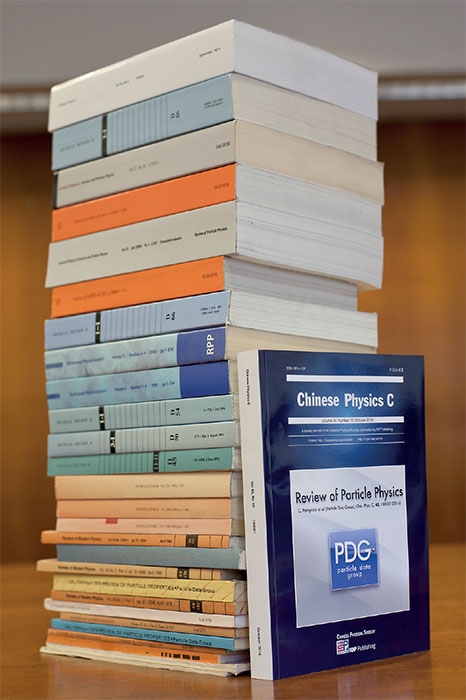
A view of the first page in the 1,898-page 2018 edition of the Review of Particle Physics.
The latest edition of the Review of Particle Physics, a go-to resource for particle physicists published Aug. 17 in the American Physical Society’s Physical Review D journal, marks the 60th anniversary of the founding of the international Particle Data Group (PDG) that produces the Review.
Sometimes referred to as the “bible of particle physics,” the Review features 41,371 measurements. There are 118 individual review articles in this 2018 edition, covering topics ranging from the recently discovered Higgs boson to searches for hypothetical particles, and to particle accelerators, detectors, and statistics.
The Review is produced by a collaboration of more than 225 experts from 159 institutions around the globe.
Distributed around the world to thousands of physicists, the Review is the most highly cited publication in its field. Since its inception, PDG has been based at the Department of Energy’s Lawrence Berkeley National Laboratory (Berkeley Lab) and its previous incarnation, the University of California Radiation Laboratory.
The Review now fills 1,898 pages. It is published every other year, and the online edition is updated annually. The latest online version of the Review was made available in June 2018. All review articles and Summary Tables are available in print as the PDG Book.
This year is also a milestone anniversary for the American Physical Society’s first publication of the Physical Review in 1893 at Cornell University in Ithaca, New York.
“I am delighted that this year’s Review of Particle Physics will appear in such a renowned journal,” said Juerg Beringer of Berkeley Lab, who has led PDG since 2016. “The fact that this year also marks the 125th anniversary of the first publication of the Physical Review makes this particularly special.”

Today marks the release of the 2018 print edition of the Review of Particle Physics. In this photo, a copy of the printed 2016 edition leans against a stack of previous editions in this photo, with the oldest issues at the bottom. (Credit: Lawrence Berkeley National Laboratory.)
APS Editor-in-Chief Michael Thoennessen said, “I am very pleased that the Particle Data Group has selected Physical Review D to publish the latest edition of the Review of Particle Physics. These reviews continue to be an indispensable resource for the particle physics community. Having the 60th anniversary issue published in Physical Review is certainly an honor.” (See a related APS press release.)
For this edition, the associated PDG Booklet, which had 344 pages in 2016, was scaled down to a more manageable pocket-size booklet with about 260 pages.
“The booklet has been stripped down to summary tables and the most relevant formulas, tables, and figures to make it as small as possible,” Beringer said.
PDG’s origins date back to a 1957 paper in the Annual Review of Nuclear Science that was authored by the late Arthur “Art” Rosenfeld and Murray Gell-Mann. Particle data tables related to that article, prepared by Rosenfeld and Walter Barkas, kicked off a long-running and expansive series now known as the Review.
The publication of the Review of Particle Physics is supported by the U.S. Department of Energy’s Office of Science; by the European Laboratory for Particle Physics (CERN); by an implementing arrangement between the governments of Japan (MEXT: Ministry of Education, Culture, Sports, Science and Technology) and a U.S. Department of Energy Cooperative Research and Development Agreement; by the Institute of High Energy Physics, Chinese Academy of Sciences; and by the Italian National Institute of Nuclear Physics (INFN).
More:
- See a related press release by the American Physical Society: 60th Anniversary Edition of Review of Particle Physics published in Physical Review D
- 2018 edition of the Review of Particle Physics
- PDG website
- The physicist’s guide to the universe, CERN Courier, Oct. 13, 2017
###
Lawrence Berkeley National Laboratory addresses the world’s most urgent scientific challenges by advancing sustainable energy, protecting human health, creating new materials, and revealing the origin and fate of the universe. Founded in 1931, Berkeley Lab’s scientific expertise has been recognized with 13 Nobel Prizes. The University of California manages Berkeley Lab for the U.S. Department of Energy’s Office of Science. For more, visit www.lbl.gov.
DOE’s Office of Science is the single largest supporter of basic research in the physical sciences in the United States, and is working to address some of the most pressing challenges of our time. For more information, please visit the Office of Science website at science.energy.gov.